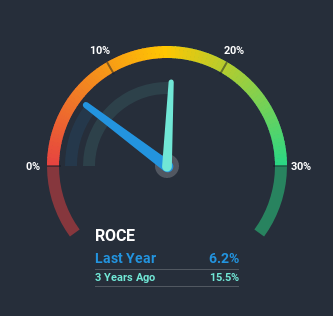Here's What To Make Of Honda India Power Products' (NSE:HONDAPOWER) Returns On Capital

There are a few key trends to look for if we want to identify the next multi-bagger. Typically, we'll want to notice a trend of growing return on capital employed (ROCE) and alongside that, an expanding base of capital employed. Ultimately, this demonstrates that it's a business that is reinvesting profits at increasing rates of return. However, after briefly looking over the numbers, we don't think Honda India Power Products (NSE:HONDAPOWER) has the makings of a multi-bagger going forward, but let's have a look at why that may be.
Return On Capital Employed (ROCE): What is it?
Just to clarify if you're unsure, ROCE is a metric for evaluating how much pre-tax income (in percentage terms) a company earns on the capital invested in its business. Analysts use this formula to calculate it for Honda India Power Products:
Return on Capital Employed = Earnings Before Interest and Tax (EBIT) ÷ (Total Assets - Current Liabilities)
0.062 = ₹351m ÷ (₹7.7b - ₹2.0b) (Based on the trailing twelve months to September 2020).
Thus, Honda India Power Products has an ROCE of 6.2%. In absolute terms, that's a low return and it also under-performs the Machinery industry average of 9.8%.
View our latest analysis for Honda India Power Products

While the past is not representative of the future, it can be helpful to know how a company has performed historically, which is why we have this chart above. If you want to delve into the historical earnings, revenue and cash flow of Honda India Power Products, check out these free graphs here.
So How Is Honda India Power Products' ROCE Trending?
On the surface, the trend of ROCE at Honda India Power Products doesn't inspire confidence. To be more specific, ROCE has fallen from 17% over the last five years. However it looks like Honda India Power Products might be reinvesting for long term growth because while capital employed has increased, the company's sales haven't changed much in the last 12 months. It's worth keeping an eye on the company's earnings from here on to see if these investments do end up contributing to the bottom line.
The Key Takeaway
Bringing it all together, while we're somewhat encouraged by Honda India Power Products' reinvestment in its own business, we're aware that returns are shrinking. Unsurprisingly then, the total return to shareholders over the last five years has been flat. On the whole, we aren't too inspired by the underlying trends and we think there may be better chances of finding a multi-bagger elsewhere.
One more thing to note, we've identified 2 warning signs with Honda India Power Products and understanding these should be part of your investment process.
While Honda India Power Products may not currently earn the highest returns, we've compiled a list of companies that currently earn more than 25% return on equity. Check out this free list here.
If you’re looking to trade Honda India Power Products, open an account with the lowest-cost* platform trusted by professionals, Interactive Brokers. Their clients from over 200 countries and territories trade stocks, options, futures, forex, bonds and funds worldwide from a single integrated account. Promoted
Valuation is complex, but we're here to simplify it.
Discover if Honda India Power Products might be undervalued or overvalued with our detailed analysis, featuring fair value estimates, potential risks, dividends, insider trades, and its financial condition.
Access Free AnalysisThis article by Simply Wall St is general in nature. It does not constitute a recommendation to buy or sell any stock, and does not take account of your objectives, or your financial situation. We aim to bring you long-term focused analysis driven by fundamental data. Note that our analysis may not factor in the latest price-sensitive company announcements or qualitative material. Simply Wall St has no position in any stocks mentioned.
*Interactive Brokers Rated Lowest Cost Broker by StockBrokers.com Annual Online Review 2020
Have feedback on this article? Concerned about the content? Get in touch with us directly. Alternatively, email editorial-team (at) simplywallst.com.
About NSEI:HONDAPOWER
Honda India Power Products
Engages in the manufacture, marketing, and sale of portable generators, water pumps, general purpose engines, lawn mowers, brush cutters, portable gensets, tillers, and marine engines in India and internationally.
Flawless balance sheet second-rate dividend payer.
Market Insights
Community Narratives




